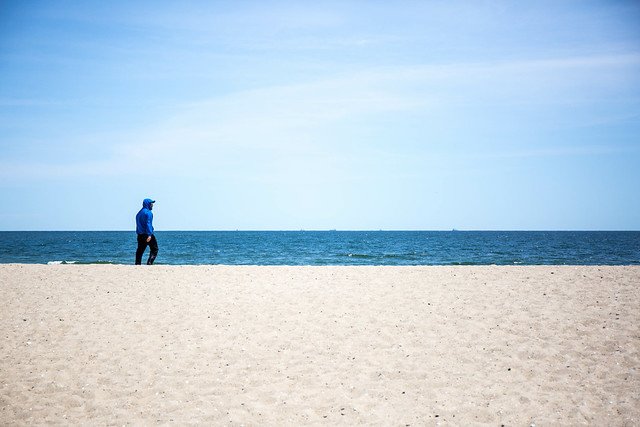Summer Seasonal Depression Is Real & Can Be 'Dangerous'
May 29, 2019, 12:20 p.m.
Reverse seasonal depression, which affects some people when it's hot out, has entirely different symptoms than its winter counterpart.

If the thought of sunshine and beaches doesn't bring you joy, you're not alone.
Welcome back to Summer Sucks. For this week's installment, we talk to a mental health expert about summer depression, a.k.a. reverse seasonal affective disorder.
The Hot Times are officially upon us. The days are getting longer, brands are milking "fun in the sun" taglines to hawk their wares, New York City-area beaches recently reopened for swimming, and stray trash bags are in the beginning stages of their annual garbage juice fermentation.
For many New Yorkers, summer means the end of short, dark days. But for others, things get more difficult during the warmer months. The subway's toasty platform, with its still air and lack of circulation, fills me with dread right around June. I often feel anxious when I walk around, getting pummeled by the hot exhaust spilling out of air-conditioning units. The slightly cooler evenings aren't much of a relief, either—I sleep fitfully during these months. One particularly brutal summer, when I was 18, my insomnia was so bad that I had to take melatonin every day and had nightmares every night.
Mental health experts have coined a term to describe the onset of anxiety, agitation, and depression that can sink in for people during the summer months: Reverse seasonal affective disorder. Far more people report feeling the effects of seasonal depression in the winter versus the summer. Some researchers believe reverse SAD affects less than 1% of the population (others believe it is more common), though it's entirely possible we'll see more incidences of summer seasonal depression in the future, given that the Earth is steadily getting hotter. But summer depression is more gnarled, which makes it both more difficult to treat and challenging to study.
It doesn't help that summer depression's symptoms are completely different from the ones that affect people during the winter, says Dr. Norman Rosenthal, who's studied seasonal affective disorders for decades. "The winter type has been more common," Rosenthal told Gothamist, noting that "the summer type is not as easy to pin down." He explained, "It may be a kind of depression, it may be a mix of depression and irritable manicky-type symptoms, it may be the clock going out of phase. Or it may actually be winter depression masquerading as summer depression because people are indoors with the shades drawn." Whatever form it takes, Rosenthal said: "It's pretty bad."
In 1987, Rosenthal, along with Dr. Thomas Wehr, published a paper in which they discussed their findings of "an opposite pattern, namely depressions in the summer and nondepressed periods in fall and winter, a condition they have called reverse-SAD." Through their later study of seasonal depression at four latitudes, Rosenthal and Wehr found that while more of their subjects in New York City reported feeling worse in winter—46.9%—a portion of people felt especially bad in the summer (14.1%).
Those grappling with summer seasonal depression felt far more prone to insomnia, compared to the hypersomnia (oversleeping) that can often happen to someone suffering from winter depression. They felt irritated and agitated, as well. "We found that they were quite different in their properties than the winter group," Rosenthal says. "They had different symptoms, they were active...they couldn’t eat properly, they lost weight. A very different profile. And they were more inclined to suicidal ideas...it is not a trivial condition. It can be quite dangerous."
It's hard to discern what causes reverse seasonal affective disorder. The risk factors include (but certainly are not limited to) people living far from the equator and genetics, and it tends to affect younger women more frequently. Higher pollen counts may be a factor, as a 2007 study focused on African and African American college students living in Washington, D.C. noted. Part of it could also be due to the longer days, which can cause someone's circadian rhythm to go out of wack. Exposure to too much sunlight might be messing with melatonin production, as well. Summertime can also inspire FOMO, and the last thing you want to do is feel pressured to have a good time for months when you're not feeling it.
Unfortunately, all of this means solutions aren't as obvious. While people can benefit from light therapy to combat seasonal depression in the winter, this method may have adverse effects for people with reverse seasonal affective disorder, whose symptoms can become aggravated by more light.
"Some people say that they get better when they stay indoors in cool air-conditioned spaces, or swim in a cool lake or take a cold bath or shower, some people say they’re helped by avoiding the light and using sunglasses," Rosenthal says. "So there’s no one simple way to treat it."
Finding things that bring you relief is key, whether that means staying inside with the curtains drawn, going to a frigid movie theater for a double feature, or putting lemon slices in a jug of cold water. As for me, having events to look forward to, and making cold brew and fruit pies have been a trusty salve. Seek out your shaded sanctuaries, and good luck out there.
Hit up Jen Carlson and Paula Mejía if you have any questions about summer in the city (use "Summer Sucks" in the subject line), or just want to commiserate. And please hashtag us in your summer misery photos with #NYCSummerSucks.